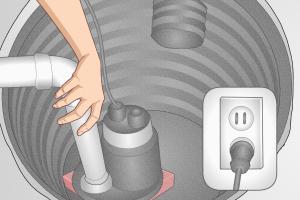Expert Guide to Cleaning Your Sump Pit: Step-by-Step Instructions

-
Quick Links:
- Introduction
- Why Clean a Sump Pit?
- When to Clean Your Sump Pit?
- Tools and Materials Needed
- Step-by-Step Guide to Cleaning a Sump Pit
- Case Studies and Real-World Examples
- Expert Insights
- Maintenance Tips for a Clean Sump Pit
- FAQs
Introduction
Your home’s sump pit is an essential component for preventing water damage in your basement. Regular maintenance is crucial to ensure its proper functioning. In this comprehensive guide, we will walk you through the process of cleaning a sump pit effectively, ensuring your home remains safe and dry.
Why Clean a Sump Pit?
A sump pit collects water from your basement and directs it away from your home’s foundation. Over time, sediment, debris, and other materials can accumulate, leading to:
- Reduced effectiveness of the sump pump
- Unpleasant odors
- Potential flooding issues
- Increased wear and tear on the pump
By cleaning the sump pit regularly, you can prevent these issues and maintain the integrity of your home.
When to Clean Your Sump Pit?
It is recommended to clean your sump pit at least once a year, ideally before the rainy season. However, consider cleaning it more frequently if you notice:
- Visible debris or buildup
- Unusual noises from the sump pump
- Increased humidity levels in the basement
Tools and Materials Needed
Before you begin the cleaning process, gather the following tools and materials:
- Gloves
- Face mask
- Bucket or wet/dry vacuum
- Scrub brush
- Dish soap or a mild detergent
- Water hose
- Flashlight
Step-by-Step Guide to Cleaning a Sump Pit
Follow these steps to clean your sump pit effectively:
Step 1: Safety First
Before you start, put on gloves and a face mask to protect yourself from dust and contaminants.
Step 2: Remove the Pump
Carefully unplug the sump pump and remove it from the pit, ensuring you don’t damage any wiring.
Step 3: Drain the Pit
Using a bucket or wet/dry vacuum, remove any standing water in the pit. Be sure to dispose of the water properly.
Step 4: Clean the Pit
Use a scrub brush and mild detergent to clean the sides and bottom of the pit. Rinse with the water hose.
Step 5: Clean the Pump
While the pit dries, clean the sump pump by rinsing it with water and removing any debris from the intake screen.
Step 6: Reassemble
Once everything is dry, reinsert the pump into the pit, plug it back in, and ensure it is functioning correctly.
Step 7: Test the System
Pour water into the pit to test the pump's operation. It should activate and drain water effectively.
Case Studies and Real-World Examples
Consider the case of a homeowner in the Midwest who neglected their sump pit for years. They experienced significant flooding during a heavy rainstorm, which could have been prevented with regular maintenance. After cleaning the sump pit, they reported a noticeable decrease in humidity and no further flooding issues.
Another example is a family in a coastal area. They cleaned their sump pit before the hurricane season, which helped ensure that their home remained dry, even in heavy rains.
Expert Insights
According to home improvement expert Mark Johnson, "Regular maintenance of your sump pit can save you thousands in potential water damage repairs. It’s a small investment of time that yields significant returns." He emphasizes the importance of being proactive rather than reactive when it comes to home maintenance.
Maintenance Tips for a Clean Sump Pit
To maintain your sump pit effectively:
- Check for debris monthly.
- Test the pump regularly to ensure it functions correctly.
- Keep the area around the sump pit clear of clutter.
FAQs
1. How often should I clean my sump pit?
It is recommended to clean your sump pit at least once a year, or more frequently if you notice buildup or issues.
2. Can I use bleach to clean my sump pit?
It is not recommended to use bleach, as it can damage the sump pump. Use mild detergent instead.
3. What should I do if my sump pump is not working?
Check for clogs, ensure it’s plugged in, and inspect the float switch. If issues persist, consider contacting a professional.
4. Is it safe to clean a sump pit myself?
Yes, as long as you take safety precautions, such as wearing gloves and a mask. If you are uncomfortable, hire a professional.
5. How can I prevent debris from accumulating in my sump pit?
Regular maintenance and keeping the area around the sump pit clear can help prevent debris buildup.
6. What are the signs that my sump pit needs cleaning?
Signs include visible debris, unusual noises from the pump, or increased humidity in the basement.
7. Can I use a garden hose to wash my sump pit?
Yes, you can use a garden hose to rinse the pit after scrubbing it.
8. What if I find mold in my sump pit?
If you find mold, it’s best to use a mold-specific cleaner and ensure proper ventilation while cleaning.
9. Should I hire a professional for sump pit cleaning?
If you feel uncomfortable doing it yourself, hiring a professional is a good option. They can also check for any underlying issues.
10. How much does it cost to have a sump pit cleaned professionally?
The cost can vary but typically ranges from $100 to $300, depending on your location and the condition of the pit.
Conclusion
Cleaning your sump pit is an essential part of home maintenance that can prevent water damage and keep your basement dry. By following the steps outlined in this guide, you can ensure that your sump pit operates efficiently and effectively. Regular maintenance not only protects your home but also provides peace of mind during heavy rains and storms.